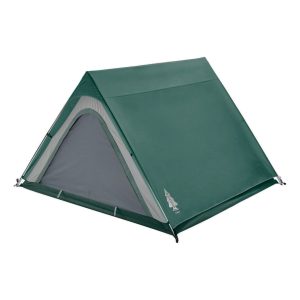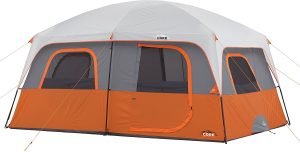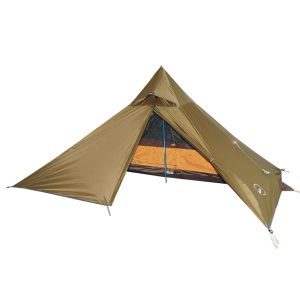A tent is one of the most important pieces of gear that any outdoors enthusiast can purchase. A good tent will protect you from the elements and offer you shelter and security when sleeping outdoors. But when you start shopping for tents, the sheer number of options can be daunting. How do you know what features you need, or even what those features are? It can be a real challenge to determine what type of tent is best for you, so we’ve created this handy guide to the various types of tents. We’ll let you know what types of tents are out there, and what you should be looking for in a tent, and we’ll recommend some great tents to get you started.
The information in this article is robust, but if you trust us with your time, we are confident you’ll leave knowing exactly what you need.
You will also get value out of our article: The Best Budget Backpacking Tents
Quick Navigation:
Tents By Shape | Specialty Tents | Tent Terminology | How To Choose
Tents By Shape
Tents can be classified in many different ways. They can be sorted by size, material, temperature rating, or shape, among other selection factors. Here, we’re going to talk about tents by their shapes. Tent shape affects how many people can fit comfortably, how well your tent resists the wind, how difficult it is to pitch or put up your tent, how much your tent will weigh at a given size, and how easily and small it packs up.
A-Frame or Ridge Tents
A-frame or ridge tents are extremely simple tents. Modern a-frames don’t even always have their own poles and are often meant to be used with trekking poles for support (an ultralight backpacking option). They’re lightweight and are often similar to tarp setups; the key difference being that a-frame tents sometimes have both a canopy and rain fly, while tarps are always one sheet. Don’t expect to be able to fit more than two people in one a-frame, but these are so compact and lightweight that it’s not that challenging for everyone to have their own.
These tents are also great in wet weather situations since water can’t pool on top, and when they’re put up well, they’re very sturdy in the wind.
Pros
- High performance in bad weather
- Versatile
- Simple to set up
- Inexpensive
- Usually lightweight
Cons
- Little headroom
Shop Tents On Amazon | Shop Tents on REI | Shop Tents On Backcountry
Dome Tents
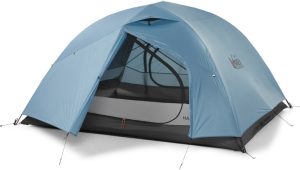 Dome tents are one of the most popular tent designs available. They offer good protection at a low weight and are very easy to pitch. Because of the popularity, it is easy to find high quality budget backpacking tents of this style. These tents have two flexible poles that cross at the top and bend to be anchored to the floor on each of the dome’s corners. This design means that they usually don’t need stakes or guy lines (though both are recommended in heavy rain or wind, and these tents come with them). These tents often have a small porch area or vestibule, which is a great place to store your gear without it taking up room in the tent. Dome tents get less stable the larger they get— dome tents rated for more than four people have decreased performance in high wind situations.
Dome tents are one of the most popular tent designs available. They offer good protection at a low weight and are very easy to pitch. Because of the popularity, it is easy to find high quality budget backpacking tents of this style. These tents have two flexible poles that cross at the top and bend to be anchored to the floor on each of the dome’s corners. This design means that they usually don’t need stakes or guy lines (though both are recommended in heavy rain or wind, and these tents come with them). These tents often have a small porch area or vestibule, which is a great place to store your gear without it taking up room in the tent. Dome tents get less stable the larger they get— dome tents rated for more than four people have decreased performance in high wind situations.
Pros
- Inexpensive
- Lightweight
- Simple to pitch— you can usually do this with one person quickly
- Small packdown size— easy to transport on your own without a vehicle
Cons
- Unstable at larger sizes
Shop Tents On Amazon | Shop Tents on REI | Shop Tents On Backcountry
Cabin Tents
Cabin tents, which often have several rooms with internal dividers, look like fabric-walled cabins! These are usually made with aluminum poles and have a lot of vertical space, which makes them very easy to move around and even stand up in. These tents are good for families or big groups, but they do have some major downsides. Because these have such high vertical wall structures, their wind resistance is minimal. They’re often cheaply made, too, and aren’t always great for serious campers due to the low quality of the material (unless you purchase a high quality and more expensive option). They’re also really bulky and awkward to pack out— but if you’re car camping with a crew of kids, this might be the type of tent you want.
Pros
- Spacious
- Great for groups
- Tons of headroom
Cons
- Often cheaply made
- Often difficult to set up
- Bulky
- Heavy (not for backpacking)
- Little wind resistance
Shop Tents On Amazon | Shop Tents on REI | Shop Tents On Backcountry
Geodesic Tents
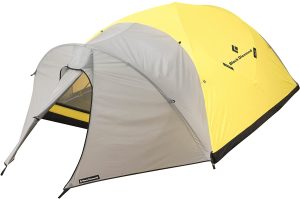 Geodesic tents are more stable than dome tents. They operate on a similar principle, but have additional crossbars for greater stability and improved wind resistance. Usually Geodesic tents have 5 or more crossing poles sections. These extra poles increase stability for harsh conditions, but also add weight. Geodesic tents’ multiple anchor points also increase the available headroom in the tent, making them quite comfortable. However, these tents don’t tend to sleep very many people; if you’re camping with your whole family, you might prefer a tent with more floor space.
Geodesic tents are more stable than dome tents. They operate on a similar principle, but have additional crossbars for greater stability and improved wind resistance. Usually Geodesic tents have 5 or more crossing poles sections. These extra poles increase stability for harsh conditions, but also add weight. Geodesic tents’ multiple anchor points also increase the available headroom in the tent, making them quite comfortable. However, these tents don’t tend to sleep very many people; if you’re camping with your whole family, you might prefer a tent with more floor space.
Pros
- Stable in adverse weather and high winds
- Durable
- Lots of headroom
- Lightweight for the weather they can handle
Cons
- Can be expensive
- Bad for large groups
- Challenging to pitch
- Heavier than a simple dome tent
Shop Tents On Amazon | Shop Tents on REI | Shop Tents On Backcountry
Pyramid Tents
These simple tents have a single central pole and are supported with guy lines and stakes. This tent shape isn’t the most comfortable for multiple people because headroom and storage space are limited, but they’re very stable in all kinds of wind conditions if pitched correctly. While older pyramid tents were quite heavy due to the central support pole often being made of wood, modern pyramid tents are made with new, lightweight materials, making it easy to find ultra lightweight minimalist tents in this style.
Pros
- Easy setup
- Lightweight
- Stable
- Inexpensive
Cons
- Limited space
- Usually no built-in floor
- Uncomfortable for more than one or two people
Shop Tents On Amazon | Shop Tents on REI | Shop Tents On Backcountry
Tunnel Tents
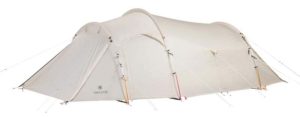 Tunnel tents are made up of a series of flexible poles that make a tunnel for the rain fly to attach to. These are one of the best tent options for larger groups and families as they often have multiple exits (so there’s less climbing over people to take nighttime bathroom breaks), lots of headroom, and plenty of sleeping space. They require guy lines to provide stability, but once you get them up they can withstand wind and weather well. However, you do need to choose your location and direction carefully; these tents need to be pitched with the short end facing the wind. You also need a lot of space for these tents; their floors have a large surface area, so they’re not great at a crowded campsite.
Tunnel tents are made up of a series of flexible poles that make a tunnel for the rain fly to attach to. These are one of the best tent options for larger groups and families as they often have multiple exits (so there’s less climbing over people to take nighttime bathroom breaks), lots of headroom, and plenty of sleeping space. They require guy lines to provide stability, but once you get them up they can withstand wind and weather well. However, you do need to choose your location and direction carefully; these tents need to be pitched with the short end facing the wind. You also need a lot of space for these tents; their floors have a large surface area, so they’re not great at a crowded campsite.
Pros
- Great for groups
- Comfortable
- Wind and weather-resistant (when pitched correctly)
Cons
- Bulky
- Cannot pitch alone
- Can be heavy
Shop Tents On Amazon | Shop Tents on REI | Shop Tents On Backcountry
Specialty Tents
These tents are less commonly used by campers in wilderness areas and require a bit more explanation than the basic tent types. Some of them are too heavy or require too much structure to be usable in the backcountry. These aren’t likely to be what a first-time tent buyer is looking for, but if you’re after a certain experience, these tents might be what you need to make that a reality.
Bell Tents
 Bell tents are most popular for “glamping” or at festivals because they can sleep huge amounts of people and are often designed to be extremely comfortable. Some of them are even designed like hot tents and can be used with wood-burning stoves! These tents are typically made of canvas and have side panels that can roll up for better temperature control. There’s a central pole that acts as the main support for these tents, and then the sides can be supported by additional poles and guy lines.
Bell tents are most popular for “glamping” or at festivals because they can sleep huge amounts of people and are often designed to be extremely comfortable. Some of them are even designed like hot tents and can be used with wood-burning stoves! These tents are typically made of canvas and have side panels that can roll up for better temperature control. There’s a central pole that acts as the main support for these tents, and then the sides can be supported by additional poles and guy lines.
The downside to these tents for camping is the cost, the size, and the weight. You can’t pack most bell tents in your backpack— you need a vehicle to transport one of these. While some people do take bell tents for extended camping trips, it’s unusual to see these in the backcountry.
Pros
- Comfortable
- Lots of room
- Many optional features
Cons
- Expensive
- Heavy
- Extremely cumbersome
- Difficult to put up
Shop Tents On Amazon | Shop Tents on REI | Shop Tents On Backcountry
Hot Tents
 Hot tents are heavy canvas tents that are designed to be used with a wood-burning stove in harsh winter conditions. You may also find them in lighter weight modern tent material options. These tents are often used by hunters and fishers, or people who enjoy snow camping. Typically, these tents and their stoves aren’t carried in a backpack, but rather are hauled on a sled. This can be a challenge if you are trying to haul one through dry forest but becomes much easier if there’s a layer of snow on the ground.
Hot tents are heavy canvas tents that are designed to be used with a wood-burning stove in harsh winter conditions. You may also find them in lighter weight modern tent material options. These tents are often used by hunters and fishers, or people who enjoy snow camping. Typically, these tents and their stoves aren’t carried in a backpack, but rather are hauled on a sled. This can be a challenge if you are trying to haul one through dry forest but becomes much easier if there’s a layer of snow on the ground.
The main advantage of hot tents is that they’re heated, making winter camping warm. These tents have a fire-resistant stove jack installed in them, which allows you to run a wood stove’s chimney through to vent smoke away from your sleeping space. Having a stove means that you can cook your food inside your tent, stay warm when sleeping, and dry your clothes. In the winter, dry clothes can mean the difference between a great experience or frostbite and hypothermia— both of which are extremely dangerous.
Pros
- Warm
- Weather-resistant
- Flexible— these come in a variety of shapes to suit your needs
Cons
- Heavy
- Difficult to set up and learn to use safely
- Requires extra equipment
- No floor
Shop Tents On Amazon | Shop Tents on REI | Shop Tents On Backcountry
Rooftop Tents
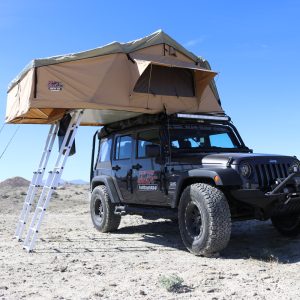 Rooftop tents require a car to function. They actually mount to the top of your vehicle! You climb a ladder to get up to the tent, which is secured to the luggage bars on top of your automobile. Usually, you see these attached to SUVs or tricks, but virtually any car with bars will work as a surface for the rooftop tent. If you’re offroading in a Jeep, on a road trip, or if you drove to your campsite and are planning on using it as a base camp for day hikes, then this type of tent might be perfect for you.
Rooftop tents require a car to function. They actually mount to the top of your vehicle! You climb a ladder to get up to the tent, which is secured to the luggage bars on top of your automobile. Usually, you see these attached to SUVs or tricks, but virtually any car with bars will work as a surface for the rooftop tent. If you’re offroading in a Jeep, on a road trip, or if you drove to your campsite and are planning on using it as a base camp for day hikes, then this type of tent might be perfect for you.
This type of tent is also popular in places with serious predator activity. If you’re planning an African safari or an Australian bushwalk, an elevated tent can protect you from lions, leopards, and venomous snakes. However, there are few places in North America where this kind of protection is truly necessary, as even our most dangerous predators like grizzly bears and wolves would rather avoid human campsites. So long as you pack your food safely and smartly, you don’t have much to worry about.
Pros
- Secure
- Comfortable— many of these come with built-in memory foam mattresses
Cons
- Requires attachment to a vehicle
- Extremely expensive— basic models start at around $1000 and if you don’t already have luggage bars, those can cost as much as $3000 to have installed
- Puts wear and tear on your car
Shop Tents On Amazon | Shop Tents on REI | Shop Tents On Backcountry
Tarps and Bivy Gear
When is a tent not a tent? When it’s a tarp! Or a bivy sack or shelter. Tarps and bivy gear are sleeping shelters that you can use that offer limited protection from the elements, but have features that may be very appealing to some campers. These lightweight options are often preferred by people who frequently hike or camp solo in the backcountry, people who camp during long-distance biking trips, and people who go winter camping in snow caves. They are also very popular with mountaineers who climb big-wall routes that take more than a day to complete.
A tarp is just that: a tarp. It’s a thin sheet of material that doesn’t come with dedicated poles. You can use trekking poles to set it up, or you can set up a line between two trees to support it. Tarps are versatile and can be tied in many configurations.
Tarps, however, have no floor or sidewalls and leave you quite exposed to the elements. If you’re only using a single tarp for shelter from the rain, it’s quite probable you will get wet. You also need to be familiar with secure knots, unless you want your tarp to fly away in the wind.
A bivy (short for bivouac) sack or bivy shelter is even more minimal. These are essentially just fabric shells you put over your sleeping bag. They were originally designed for climbers who wanted lightweight emergency weather protection during prolonged, multi-day ascents.
Bivy sacks are the most minimal kind of shelter. They may keep you dry, but if you have any issues with claustrophobia, this camping shelter is not for you. The fabric of the sack drapes over your sleeping bag, and there’s a hole for breathing. For some campers, this is ideal as it gives them a better feeling of connecting with nature. For others, this exposure or the feeling of fabric on their face makes them quite uncomfortable.
Bivy shelters are slightly more advanced than bivy sacks. They have an expanded area of protected headroom that’s supported by hoops or poles, and a full enclosure to protect you from bugs and the weather.
Pros
- Ultra-lightweight
- Versatile
- Inexpensive
Cons
- Exposure
- Less shelter than any other kind of tent
- Generally better suited for experts
Shop Tents On Amazon | Shop Tents on REI | Shop Tents On Backcountry
Tent Tips for the First-Time Buyer
So now that you know what your tent options are, it’s likely time to buy your tent. When you’re buying your first tent, or considering other tent options for your needs, you need to ask yourself the following questions:
- How many people am I camping with, and how much gear are they bringing?
- Where do I like to camp? Am I going to be hiking out into the woods, or am I going to be car camping at my favorite state park?
- What’s my budget?
- How much weight am I comfortable adding to my pack? Will I be able to split the pieces of the tent with a buddy, or am I on my own?
- What’s the weather like where I usually camp?
By answering these questions, you will be able to determine the options you need and the bonus features you want. From there, the selection process is easier.
You should also consider the following tips when choosing a tent. They can help you answer those questions and help you choose the tent that’s most comfortable for you and your camping situation.
1. Avoid Overcrowding
When a tent says it’s meant for four people, that usually means that four people can sleep in it, but there’s likely no room for their stuff. No industry standard defines tent dimensions on a per-person basis. You might want to consider upsizing your tent by one or even two people more than you normally share a tent with. That way it’s less claustrophobic, there’s room for your gear, and everybody has a little more room to spread out. This rule needs some caution for backpackers. As added tent space means added weight and pack size.
2. Consider Trail Weight vs. Packaged Weight
Tents typically have two listed weights: the trail weight and the packaged weight. The trail weight includes the tent body, rain fly, and tent poles. The packaged weight also includes tent stakes, stuff sacks, the footprint, and anything else that comes with the tent. Make sure you when comparing tent weights, you are looking at the whole picture.
3. Check The Vents
A poorly-ventilated tent is a miserable experience. It’ll be hot and stuffy as you’re trying to go to sleep. And in the morning… Well, that’s when the condensation comes. You, your clothing, your bedding, and everything else in the tent will be uncomfortably damp. Avoid this by choosing a tent that’s well-ventilated, even with the rain fly on.
Tent Technical Terms
Numerous technical terms show up in tent product specifications. Many of these refer to aspects of how the tent is pitched or constructed and can seem like confusing jargon when you’re shopping for a tent. Here’s a glossary of some of the most common terms and what they mean.
| Term | Definition |
| Canopy | The main body of the tent. This is the inner wall of a double-walled tent. |
| Footprint | Specialized ground cloth that goes under the tent and fits it perfectly. Prevents water from entering. These are usually sold separately, and you can even DIY a footprint if you’re crafty. |
| Gear Garage/Gear Loft | Storage space for gear. A gear garage is like a mini tent or a vestibule for your gear; a gear loft is essentially a hammock that takes advantage of extra headroom to store gear. |
| Ground Cloth | Any tarp or cloth that goes under the tent. |
| Guy Line | A cord used to secure the tent to the ground. |
| Guy Out Loops/Tie Out Points | These are the attachment points for guy lines. |
| Headroom | Vertical space. The more headroom you have, the easier it is to stand in your tent. |
| Poles | The skeleton of your tent. These are most commonly made from fiberglass, composite, or aluminum. |
| Quick Pitch | Tents marketed as “quick pitch” or “instant” or “pop-up” are pre assembled and collapsed. Great for festivals, the beach, family hikes, and car camping. Not great for the rough backcountry. |
| Rain Fly | Sometimes just called the fly, this is the outer wall of a double-wall tent. |
| Tub Floor | A floor that has short walls of waterproof material that usually comes up to the door of the tent. These are designed to keep water out without needing a footprint. |
| Vestibule | Protected area outside the main space of the tent, usually created by the fly overhanging the canopy. Some vestibules have mesh panels to act as a “porch” or extra living space. |
Which Tent Should I Buy?
Ultimately, the best tent for you is the one that meets your needs as a camper— and only you know what those are. We’ve picked some tents that can meet various needs, so if you’re still not sure where to start, check out our recommendations!
If you ask yourself key questions, determine the type of tent you need, and then purchase from a reputable brand, you’ll likely have an option that suits you perfectly.
If you liked this content, please continue your tent shopping from our links to help support the creation of content like this:
Shop Tents On Amazon | Shop Tents on REI | Shop Tents On Backcountry
Max DesMarais is the founder of hikingandfishing.com. He has a passion for the outdoors and making outdoor education and adventure more accessible. Max is a published author for various outdoor adventure, travel, and marketing websites. He is an experienced hiker, backpacker, fly fisherman, backcountry skier, trail runner, and spends his free time in the outdoors. These adventures allow him to test gear, learn new skills, and experience new places so that he can educate others. Max grew up hiking all around New Hampshire and New England. He became obsessed with the New Hampshire mountains, and the NH 48, where he guided hikes and trail runs in the White Mountains. Since moving out west, Max has continued climbed all of the Colorado 14ers, is always testing gear, learning skills, gaining experience, and building his endurance for outdoor sports. You can read more about his experience here: hikingandfishing/about

